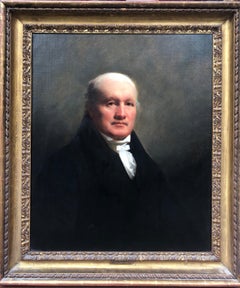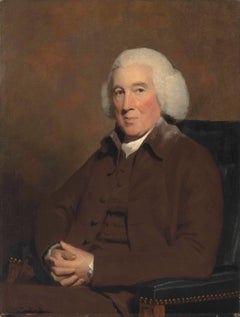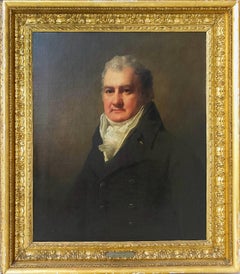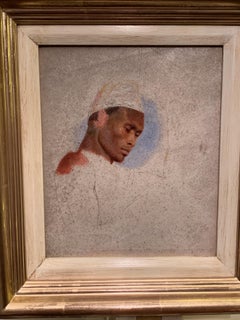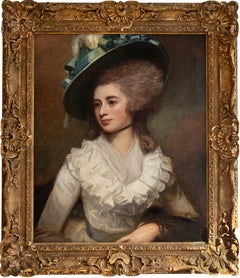Sir Henry Raeburn Art
to
1
2
2
1
3
1
1
3
Overall Height
to
Overall Width
to
1
4
3
3
2
2
1
1
3
1
3
4
6,961
3,321
2,514
1,213
4
4
Artist: Sir Henry Raeburn
Striking 18th Century Portrait of the 12th Earl of Caithness
By Sir Henry Raeburn
Located in London, GB
Sir Henry Raeburn (1756-1823)
James Sinclair, 12th Earl of Caithness (1766-1823)
Oil on Canvas
30 X 25 inches Unframed
37 X 32 inches framed
Sir Henry Raeburn FRSE RA RSA (4 March 1756 – 8 July 1823) was a Scottish portrait painter and Scotland's first significant portrait painter since the Union to remain based in Scotland. He served as Portrait Painter to King George IV in Scotland.
Raeburn was born the son of a manufacturer in Stockbridge, on the Water of Leith: a former village now within the city of Edinburgh. He had an older brother, born in 1744, called William Raeburn. His ancestors were believed to have been soldiers, and may have taken the name "Raeburn" from a hill farm in Annandale, held by Sir Walter Scott's family. Orphaned, he was supported by William and placed in Heriot's Hospital, where he received an education. At the age of fifteen he was apprenticed to the goldsmith James Gilliland of Edinburgh, and various pieces of jewellery, mourning rings and the like, adorned with minute drawings on ivory by his hand, still exist. Soon he took to the production of carefully finished portrait miniatures; meeting with success and patronage, he extended his practice to oil painting, at which he was self-taught. Gilliland watched the progress of his pupil with interest, and introduced him to David Martin, who had been the favourite assistant of Allan Ramsay the Latter, and was now the leading portrait painter in Edinburgh. Raeburn was especially aided by the loan of portraits to copy. Soon he had gained sufficient skill to make him decide to devote himself exclusively to painting. George Chalmers (1776; Dunfermline Town Hall) is his earliest known portrait.
In his early twenties, Raeburn was asked to paint the portrait of a young lady he had noticed when he was sketching from nature in the fields. Ann was the daughter of Peter Edgar of Bridgelands, and widow of Count James Leslie of Deanhaugh. Fascinated by the handsome and intellectual young artist, she became his wife within a month, bringing him an ample fortune. The acquisition of wealth did not affect his enthusiasm or his industry, but spurred him on to acquire a thorough knowledge of his craft. It was usual for artists to visit Italy, and Raeburn set off with his wife. In London he was kindly received by Sir Joshua Reynolds, the president of the Royal Academy, who advised him on what to study in Rome, especially recommending the works of Michelangelo, and gave Raeburn letters of introduction for Italy. In Rome he met his fellow Scot Gavin Hamilton, Pompeo Girolamo Batoni and Byers, an antique dealer whose advice proved particularly useful, especially the recommendation that "he should never copy an object from memory, but, from the principal figure to the minutest accessory, have it placed before him." After two years of study in Italy he returned to Edinburgh in 1787, and began a successful career as a portrait painter. In that year he executed a seated portrait of the second Lord President Dundas.
Examples of his earlier portraiture include a bust of Mrs Johnstone of Baldovie and a three-quarter-length of Dr James Hutton: works which, if somewhat timid and tentative in handling and not as confident as his later work, nevertheless have delicacy and character. The portraits of John Clerk, Lord Eldin, and of Principal Hill of St Andrews belong to a later period. Raeburn was fortunate in the time in which he practised portraiture. Sir Walter Scott, Hugh Blair, Henry Mackenzie, Lord Woodhouselee, William Robertson, John Home, Robert Fergusson, and Dugald Stewart were resident in Edinburgh, and were all painted by Raeburn. Mature works include his own portrait and that of the Rev. Sir Henry Moncrieff Wellwood, a bust of Dr Wardrop of Torbane Hill, two full-lengths of Adam Rolland of Gask, the remarkable paintings of Lord Newton and Dr Alexander Adam in the National Gallery of Scotland, and that of William Macdonald of St Martin's. Apart from himself, Raeburn painted only two artists, one of whom was Sir Francis Leggatt Chantrey, the most important and famous British sculptor of the first half of the 19th century. It has recently been revealed that Raeburn and Chantrey were close friends and that Raeburn took exceptional care over the execution of his portrait of the sculptor, one of the painter's mature bust-length masterpieces.
It was commonly believed that Raeburn was less successful in painting female portraits, but the exquisite full-length of his wife, the smaller likeness of Mrs R. Scott Moncrieff in the National Gallery of Scotland, and that of Mrs Robert Bell, and others, argue against this. Raeburn spent his life in Edinburgh, rarely visiting London, and then only for brief periods, thus preserving his individuality. Although he, personally, may have lost advantages resulting from closer association with the leaders of English art, and from contact with a wider public, Scottish art gained much from his disinclination to leave his native land. He became the acknowledged chief of the school which was growing up in Scotland during the early 19th century, and his example and influence at a critical period were of major importance. So varied were his other interests that sitters used to say of him, "You would never take him for a painter till he seizes the brush and palette."
In 1812 he was elected president of the Society of Artists in Edinburgh; and in 1814 associate, and in the following year full member, of the Royal Scottish Academy. On 29 August 1822 he was knighted by George IV and appointed His Majesty's limner for Scotland at the Earl of Hopetoun house. He died in Edinburgh.
Raeburn had all the essential qualities of a popular and successful portrait painter. He was able to produce a telling and forcible likeness; his work is distinguished by powerful characterisation, stark realism, dramatic and unusual lighting effects, and swift and broad handling of the most resolute sort. David Wilkie recorded that, while travelling in Spain and studying the works of Diego Velázquez, the brushwork reminded him constantly of the "square touch" of Raeburn. Scottish physician and writer John Brown wrote that Raeburn "never fails in giving a likeness at once vivid, unmistakable and pleasing. He paints the truth, and he paints it with love".
Raeburn has been described as a "famously intuitive"portrait painter. He was unusual amongst many of his contemporaries, such as Reynolds, in the extent of his philosophy of painting directly from life; he made no preliminary sketches. This attitude partly explains the often coarse modelling and clashing colour combinations he employed, in contrast to the more refined style of Thomas Gainsborough and Reynolds. However these qualities and those mentioned above anticipate many of the later developments in painting of the 19th century from romanticism to Impressionism.
Sir Henry Raeburn died in St Bernard's House (17 St Bernards Crescent), Stockbridge, Edinburgh. He is buried in St. Cuthbert's churchyard against the east wall (the monument erected by Raeburn in advance) but also has a secondary memorial in the Church of St John the Evangelist, Edinburgh.
James Sinclair, 12th Earl of Caithness was born at Barrogill Castle (Castle of Mey) on 31 May 1766. He was the son of Sir John Sinclair of Mey, Baronet who he succeeded in the baronetcy in 1774. He succeeded as 12th earl of Caithness in 1789.
He was lord-lieutenant of the county of Caithness and lieutenant-colonel of the Ross-shire militia.
He married at Thurso Castle on 2 January 1784 Jane, second daughter of Alexander Campbell...
Category
18th Century Sir Henry Raeburn Art
Materials
Oil
Portrait of Mrs. Johnstone
By Sir Henry Raeburn
Located in Miami, FL
This is one of Raeburns best works from his best period that is not in a museum or private collection.
Three-quarter length portrait, seated in a white dress with a black scarf over...
Category
Early 1800s Realist Sir Henry Raeburn Art
Materials
Oil
18th Century Oil Painting Portrait of Provost John Pitcairn of Dundee
By Sir Henry Raeburn
Located in London, GB
The pendant to the present portrait showing John Pitcairn's wife Jean, née Robertson, is in the Huntington Art Gallery, San Marino. Both works are datable to the 1790s. Pitcairn, who served as Provost of Dundee from 1782-84, a position his father-in-law also held from 1731-32, later sat to Raeburn for another portrait, dated to circa 1820, which is now in the Royal Scottish Academy, Edinburgh
Sale of Christie's London: Wednesday, July 9, 2014 [Lot 00212]
Old Master & British Paintings Day Sale
Sold For 22,500 GBP Premium
Provenance
By descent from the sitter to his great-grandson,
Ronald Andrew Pitcairn of Pitcullo; Christie's, London, 25 June 1904, lot 58 (200 gns. to Wallis).
Alexander Reid, Glasgow.
With Agnew's, London, where acquired by A.R. Wilson Wood, 7 April 1909; Christie's, London, 26 June 1914, lot 78 (850 gns. to Agnew).
Anonymous sale; Christie's, London, 24 November 1972, lot 27 (320 gns.)
Private collection, Dublin, Ireland
Exhibition
Edinburgh, Royal Scottish Academy, 1876, no. 256
Literature
W. Armstrong, Sir Henry Raeburn, London, 1901, p. 110.
J. Greig, Sir Henry Raeburn, R.A., His life and work with a catalogue of his pictures, London, 1911, p. 55.
R. Asleson and S.M. Bennett, British Paintings at The Huntington, New Haven and London, 2001, p. 312, fig. 12
Sir Henry Raeburn FRSE RA RSA (4 March 1756 – 8 July 1823) was a Scottish portrait painter and Scotland's first significant portrait painter since the Union to remain based in Scotland. He served as Portrait Painter to King George IV in Scotland.
Raeburn was born the son of a manufacturer in Stockbridge, on the Water of Leith: a former village now within the city of Edinburgh. He had an older brother, born in 1744, called William Raeburn. His ancestors were believed to have been soldiers, and may have taken the name "Raeburn" from a hill farm in Annandale, held by Sir Walter Scott's family. Orphaned, he was supported by William and placed in Heriot's Hospital, where he received an education. At the age of fifteen he was apprenticed to the goldsmith James Gilliland of Edinburgh, and various pieces of jewellery, mourning rings and the like, adorned with minute drawings on ivory by his hand, still exist. Soon he took to the production of carefully finished portrait miniatures; meeting with success and patronage, he extended his practice to oil painting, at which he was self-taught. Gilliland watched the progress of his pupil with interest, and introduced him to David Martin, who had been the favourite assistant of Allan Ramsay the Latter, and was now the leading portrait painter in Edinburgh. Raeburn was especially aided by the loan of portraits to copy. Soon he had gained sufficient skill to make him decide to devote himself exclusively to painting. George Chalmers (1776; Dunfermline Town Hall) is his earliest known portrait.
In his early twenties, Raeburn was asked to paint the portrait of a young lady he had noticed when he was sketching from nature in the fields. Ann was the daughter of Peter Edgar of Bridgelands, and widow of Count James Leslie of Deanhaugh. Fascinated by the handsome and intellectual young artist, she became his wife within a month, bringing him an ample fortune. The acquisition of wealth did not affect his enthusiasm or his industry, but spurred him on to acquire a thorough knowledge of his craft. It was usual for artists to visit Italy, and Raeburn set off with his wife. In London he was kindly received by Sir Joshua Reynolds, the president of the Royal Academy, who advised him on what to study in Rome, especially recommending the works of Michelangelo, and gave Raeburn letters of introduction for Italy. In Rome he met his fellow Scot Gavin Hamilton, Pompeo Girolamo Batoni and Byers, an antique dealer whose advice proved particularly useful, especially the recommendation that "he should never copy an object from memory, but, from the principal figure to the minutest accessory, have it placed before him." After two years of study in Italy he returned to Edinburgh in 1787, and began a successful career as a portrait painter. In that year he executed a seated portrait of the second Lord President Dundas.
Examples of his earlier portraiture include a bust of Mrs Johnstone of Baldovie and a three-quarter-length of Dr James Hutton...
Category
18th Century Old Masters Sir Henry Raeburn Art
Materials
Oil
Half Length Portrait of Mr. Robertson of Edinburgh
By Sir Henry Raeburn
Located in Miami, FL
Half Length Portrait of Mr. Robertson
Sir. Henry Raeburn ( Scottish 1756 - 1823 )
Half Length Portrait of Mr. Robertson
29x 24
Purchased, J Leger & Son,...
Category
18th Century Realist Sir Henry Raeburn Art
Materials
Oil
Related Items
19thc century classical French portrait sketch of a North African mans head
Located in Woodbury, CT
Outstanding small oil on velum sketch of a North African/ Arab head study.
The painting is a classic sketch and I'm sure the figure would have been used in a much larger finished w...
Category
1850s Old Masters Sir Henry Raeburn Art
Materials
Oil
Free Shipping
H 12 in W 10 in
Portrait of Lady Caroline Price
By George Romney
Located in Miami, FL
DESCRIPTION: Perhaps the best Romney in private hands. If Vogue Magazine existed in the late 18th century, this image of Lady Caroline Price would be ...
Category
1970s Old Masters Sir Henry Raeburn Art
Materials
Canvas, Oil
17th century By Neapolitan maestro San Vincenzo Ferreri Oil on canvas
Located in Milano, Lombardia
“Timete Deum et date Illi honorem quia venit hora iudicii Eius” (Fear the Lord and honour Him, for the hour of His judgement has come): the passage from John's Apocalypse (chapter 14...
Category
17th Century Old Masters Sir Henry Raeburn Art
Materials
Canvas, Oil
H 24.81 in W 19.1 in D 1.97 in
Huge 18th Century English Oil Aristocratic Portrait of a Gentleman Standing
Located in Cirencester, Gloucestershire
Portrait of an Aristocratic Gentleman
British artist, first half 18th century
oil on canvas, unframed
canvas: 50 x 40 inches
provenance: private collection, Dorset, England
condition...
Category
18th Century Old Masters Sir Henry Raeburn Art
Materials
Oil, Canvas
Old Master Painting of Christ 17th/18th Century Italian School
Located in Rochester, NY
The crucifixion of Crist Italian school 17th or 18th century. Beautiful detail in the face and hands. The lighting makes the figure of Crist seem to glow. In a good quality later frame.
Presented by Joseph Dasta Antiques...
Category
18th Century Old Masters Sir Henry Raeburn Art
Materials
Fabric, Canvas, Oil
18th century portrait of the painter Nathaniel Dance
Located in London, GB
Collections:
Robert Gallon (1845-1925);
Private Collection, UK.
Oil on canvas laid down on panel
Framed dimensions: 11.5 x 10 inches
This highly engaging, previously unpublished portrait by Johan...
Category
18th Century Old Masters Sir Henry Raeburn Art
Materials
Oil, Wood Panel, Canvas
17th Century Dutch Old Master Oil Painting Oval Shape Figures in Tavern Interior
Located in Cirencester, Gloucestershire
Tavern Interior
Dutch School, 17th century
oil on metal, framed
framed: 8 x 6.75 inches
painting: 6 x 4.25 inches
provenance: private collection
condition: very good and sound condit...
Category
17th Century Old Masters Sir Henry Raeburn Art
Materials
Oil
Flemish School, 17th Century, Mary Magdalene
Located in Stockholm, SE
Flemish School, 17th Century
Mary Magdalene
oil on copper
17th century
plate dimensions 23 x 17 cm
frame 27 x 22 cm
Restored by professional art conservator 2022.
Provenance: ...
Category
17th Century Old Masters Sir Henry Raeburn Art
Materials
Copper
Gospel Scene on Sunrise Jesus Passing Peter 19th Century Oil Painting on Canvas
Located in Stockholm, SE
Gospel of Apostle Luke, Chapter 22:
61. and the Lord turned and looked at Peter; and Peter remembered the word of the Lord, how he had said to him, “Befor...
Category
Late 19th Century Realist Sir Henry Raeburn Art
Materials
Canvas, Wood, Cotton Canvas, Oil
"Sashenka" Oil cm. 40 x 50 1981 Woman, Russia, snow
Located in Torino, IT
Woman, Russia, snow,Portraits
Levitin, Anatoly Pavlovich or Levitine,
Russian, 20th century,
Born 1922, in Petrograd (now St Petersburg).
Painter. Figures, nudes, genre scenes.
Socialist Realism...
Category
1980s Realist Sir Henry Raeburn Art
Materials
Oil, Cardboard
"Last Chukka" oil of Polo groom with his obedient Polo horse in Wellington, FL
Located in Charleston, US
Scottish artist, David McEwen's oil painting, "Last Chukka" of a Polo groom with polo horse in Wellington, FL in the US depicts the life of Palm Beach Polo Season. McEwen is renown ...
Category
21st Century and Contemporary Realist Sir Henry Raeburn Art
Materials
Oil
PORTRAIT OF A GENTLMEN - French School -Portrait Italian Oil on Canvas Painting
By Eugenio De Blasi
Located in Napoli, IT
Portrait of a Gentlemen - Oval oil on canvas cm.50x40, Italia, 2006 Eugenio De Blasi
Wooden frame available on request
The portrait of Eugenio De Blasi is inspired by one of the many portraits painted by Guillam Francois Colson, a French historian painter, who painted portraits of families...
Category
Early 2000s Old Masters Sir Henry Raeburn Art
Materials
Canvas, Oil
Sir Henry Raeburn art for sale on 1stDibs.
Find a wide variety of authentic Sir Henry Raeburn art available for sale on 1stDibs. You can also browse by medium to find art by Sir Henry Raeburn in oil paint, paint and more. Much of the original work by this artist or collective was created during the 18th century and is mostly associated with the Old Masters style. Not every interior allows for large Sir Henry Raeburn art, so small editions measuring 24 inches across are available. Customers who are interested in this artist might also find the work of Constance Anne Parker, Andrew Grant Kurtis, and Fiona Morley. Sir Henry Raeburn art prices can differ depending upon medium, time period and other attributes. On 1stDibs, the price for these items starts at $27,622 and tops out at $522,000, while the average work can sell for $138,338.
Artists Similar to Sir Henry Raeburn
Questions About Sir Henry Raeburn Art
- 1stDibs ExpertApril 5, 2022Henry Raeburn is famous for his work as a portrait artist. King George IV made the Scottish artist his official portrait painter based in Scotland. Raeburn was born 1756 and died in 1823. Find a range of Henry Raeburn art on 1stDibs.
